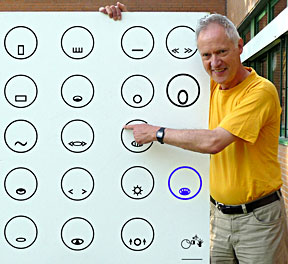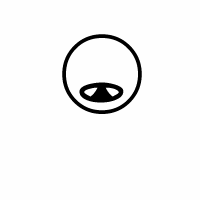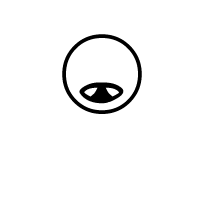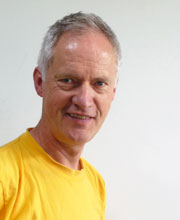|
 |
 |
 |
 |
 |
 |
|
Symposium
Presentation
0002
1
ABSTRACT
2
VIDEO
3
Animation
4
PAPERS
5
AUTHOR |
|
|
|
ENGLISH
“Wöhrmann´s SpeechWriting, in SignWriting
Documents, Teaches Deaf Students
Spoken Language.”
by
Stefan Wöhrmann
Teacher of Deaf Children
Osnabrück School for the Deaf (LZBH)
Landesbildungszentrum fur Hoergeschaedigte
August-Hoelscher-Straße 89,
49080 Osnabrück, Germany
stefanwoehrmann@gebaerdenschrift.de
It is my experience, as a teacher of Deaf children in the Osnabrück School for the Deaf since 1991, where I have taught Deaf children SignWriting and Wöhrmann's SpeechWriting since the year 2000, that Deaf children have received enormous benefit from being able to read documents in written sign language, and to also be able at the same time, to read the mouth-movements of the corresponding words, and thus improve their oral "spoken-language" skills. It is remarkable seeing Deaf children's language skills improve using a combination of Sutton SignWriting and Wöhrmann's SpeechWriting.
In my presentation, I will give a more detailed history behind this development, but here is a brief summary...
Back in 1999, when I first learned that deaf children in Nicaragua have the opportunity to create written documents in their sign language and read, it was clear to me that the SignWriting script represents a breakthrough in deaf education.
The intensive exchange with the inventor of Sutton SignWriting, Valerie Sutton, and many hours of self-taught studies, encouraged me in the belief that deaf children can benefit enormously with the inclusion of Gebaerdenschrift (the name for SignWriting in Germany), in order to improve and develop their "ORAL" language skills.
My experiences in the early days were initially very sobering. My goal was to help my Deaf students read spoken language textbooks. I wrote the equivalent signs from German Sign Language in SignWriting to translate these books into written sign language. After a few days I realized that I had difficulty reading my own writing! I found that translating between written sign language and written spoken language was not an easy task. It was hardly possible for my students to reproduce my sign-language-writing into German spoken-language sentences. What was the problem?
I realized that in German Sign Language (and probably not only there) a high proportion of information while signing is displayed through mouth movements. In addition to the general mime-like mouth gestures that occur naturally in sign languages (that have no connection to a spoken language), in German signing, we also read the articulatory mouth movements that occur when the speaker "mouthes" or speaks German words, or parts of words, without a voice, while signing.
At first, my initial task in 1999 was to write a German Sign Language Dictionary in SignWriting with the SignWriter DOS computer program. I developed a large dictionary. In the early days, the dictionary entries stored there did not record the mouth movements associated with "speech"...only the signs.
But using those signs in sentences was a different experience. I found that the reading and interpretation of such sign language documents for the experienced reader was a difficult guessing game, without the associated "speech movements" on the mouth written in combination with each sign.
So I started & developed
WOEHRMANN’S SPEECHWRITING
which includes two sections…
1. Mundbildschrift (exact translation: Mouth Picture Writing)
A standardized writing system for picturing the sounds of human spoken language (speech). Compared to the International Phonetic Alphabet, Mundbildschrift is not as detailed and complete but easy to read and sufficient enough to support even young deaf students in their articulation process to develop better spoken language skills. It is used like a spelling system for writing complete words in mouth pictures, and can be applied to any spoken language.
2. Mundbilder (writing what is seen, when Lip Reading)
A standardized writing system for picturing the way the lips look when a person speaks words. These symbols do not represent sounds but can be associated with spoken words, that are seen on the lips when “Lip Reading”. In my classroom, these symbols are always written to support the reader in reading SignWriting documents fluently.
More About Mundbildschrift
"Mundbildschrift" is a notation to transcribe the sounds of spoken German and to support deaf students in their effort to improve the articulation of German words. Mundbildschrift is a stand alone symbolset focusing on sound-production and there are no additional symbols involved that can be associated with sign language. These sounds are widely transcribed by means of the International Phonetic Alphabet (IPA). Contrary to the IPA which is difficult to read for young children, it has been my goal to offer a notation that can be understood easily by deaf first grade students at age 6. So it had to be in some way iconic. And in fact, it is very easy for every 3 year old child to "read" the first symbol combinations like "MA", "ME", "MI", "MO" "MU" and the first words like "MAMA", "OMA" or "PAPA". And it is so much fun!
This "Mundbildschrift" notation is similar in form to the IPA (International Phonetic Alphabet), with an exact 1 to 1 mapping of spoken sounds and relevant symbols. For this purpose, I developed a number of additional mouth symbols that are not included in the Sutton SignWriting symbolset, but are needed for writing the sounds of spoken language. I had to distinguish between long and short vowels, voiced or voiceless, and oral or nasal sounds. I started to concentrate on spoken German but nevertheless put some energy and work in the development to support English or Brazilian-Portuguese spoken language as well.
More About Mundbilder
For writing "Mundbilder in GebärdenSchrift" ("articulatory mouth movements"), I developed a system of notation using the Sutton SignWriting mouth symbols that could be found in the symbolset of the SignWriter DOS computer program. In order to add some new additional "mouth symbols" that I needed for my idea, I combined tiny elements of other symbols located in the software, and in this way I created a “software-supported option” to write what I wanted the reader to know. Using these symbols, and then giving the structure of how to write the way spoken German words look on the mouth while speaking, became what I call "Mundbilder in GebärdenSchrift", or "articulatory movement writing".
In contrast to the symbols of Mundbildschrift, the "mouth-symbols" in SignWriting documents are strictly separated from any auditory impression of spoken language. They are based exclusively on visual aspects. This distinction is important to understand the difficulties in lipreading. The deaf cannot hear what the speaker says. The severely hearing impaired person receives only a very vague acoustic impression of spoken language. The deaf child sees the speaker and his lip-movements, but has to guess the meaning of the message, which is much easier in the company of information coming from the hands.
Although some symbols from Mundbildschrift are also used in SignWriting documents, they may not be interpreted in the same way. There are no differences between long and short vowels, voiced or voiceless, and oral or nasal sounds and there is no symbol for “H”. Accordingly, the assignments made here as well as in lip-reading in part are ambiguous and require some oral language skills in the corresponding sign language associated with spoken language. I'll try to explain the difference between the two systems in more detail in my presentation. Using numerous examples, it should be possible to understand my invention.
Now in Brazil!
Now Wöhrmann`s SpeechWriting is also successful in Brazil for Brazilian-Portuguese spoken language and LIBRAS (Brazilian Sign Language). Used in the notation of gestures, an international standardization and a consistent interpretation of these mouth icons could be desirable and advantageous.
The mouth images in SignWriting can be used in conjunction with reading written sign language gestures and will be interpreted easily and thus allow the reader a rapid meaningful reading, provided the reader has a sufficient sign language and spoken language vocabulary.
In my presentation, I will provide a detailed list of SpeechWriting symbols, which will include their corresponding assignments to each letter of the German spoken language alphabet, which will help the interested reader to quickly become immersed in this system.
My name sign "Stefan" written in two different ways below:
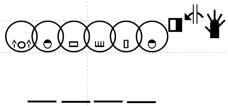
|

|
Mundbilder in GebärdenSchrift |
Mundbildschrift |
...download PDF...
DEUTSCH
"Wöhrmanns Mundbildschrift in Gebärdenschrift
Dokumente, Lehrt Gehörlose Studierende
Gesprochene Sprache. "
by
Stefan Wöhrmann
Teacher of Deaf Children
Osnabrück School for the Deaf (LZBH)
Landesbildungszentrum fur Hoergeschaedigte
August-Hoelscher-Straße 89,
49080 Osnabrück, Germany
stefanwoehrmann@gebaerdenschrift.de
Als ich erstmals erfuhr, dass gehörlose Kinder in Nicaragua die Möglichkeit haben, schriftliche Dokumente in ihrer Gebärdensprache zu schreiben und zu lesen, stand für mich fest, dass dies ein Durchbruch in der Gehörlosenpädagogik darstellt.
Der intensive Austausch mit der Erfinderin von Sutton SignWriting Valerie Sutton und viele Stunden autodidaktischer Studien bestärkten mich in der Überzeugung, dass gehörlose Kinder durch die Einbeziehung der GebärdenSchrift (so nennen wir diese Notationsform für Gebärdensprache in Deutschland) enorm profitieren können, um eine bessere Lautsprachkompetenz zu entwickeln.
Meine Erfahrungen in der Anfangszeit waren zunächst sehr ernüchternd. Nach wenigen Tagen hatte selbst ich Schwierigkeiten, die von mir verfassten Texte korrekt in die Lautsprache zu übersetzen. Meinen Schülern war es kaum möglich, die von mir geschriebenen Sätze in deutscher Lautsprache wiederzugeben. Was war das Problem?
Ich erkannte, dass in der deutschen Gebärdensprache ( und wahrscheinlich nicht nur da) ein hoher Anteil an Information über das Mundbild beim Gebärdenvortrag vermittelt wird. Neben der allgemein unkritisch gesehenen Mundgestik beim Gebärden, beobachten wir auch Mundbewegungen, die entstehen, wenn der Vortragende deutsche Wörter oder Teile dieser Wörter ohne Stimme spricht. Meine bis dahin im SignWriter DOS Wörterbuch abgelegten Gebärdeneinträge berücksichtigten diese "Sprechbewegungen" nicht. Allein auf die manuellen Anteile einer Gebärde reduziert, wird die Interpretation solcher Schriftstücke für den geübten Leser ein schwieriges Ratespiel.
So machte ich mich daran und entwickelte zwei verschiedene Notationssysteme, die aufgrund ihrer Verwandtschaft und Ähnlichkeit leider immer wieder vermischt werden. Es handelt sich dabei um "Woehrmann's SpeechWriting" und zum Zweiten um die "Mundbildschrift". Die Mundbildschrift ist eine Notation, die das Hören und Sprechen von Lautsprache unterstützen soll. Diese Notationsform hat ähnlich der IPA eine exakte 1:1 Zuordnung von gesprochenem Laut und entsprechendem Symbol. Für diesen Zweck entwickelte ich zahlreiche zusätzliche Symbole, die im Sutton Symbolset nicht aufgenommen sind. In dieser Präsentation möchte ich mich aber auf die zweite Entwicklung konzentrieren.
Ich möchte darauf eingehen, dass es sich bei "Woehrmann`s SpeechWriting" - also den Mundbildern in der GebärdenSchrift - um Mundbildsymbole handelt, die rein visuell den Sprechbewegungen zugeordnet sind. Die Verwendung dieser Symbole orientiert sich nur grob an der Schreibweise der Wörter der deutschen Lautsprache. Dementsprechend sind die hier getroffenen Zuordnungen genauso wie beim Lippenlesen zum Teil mehrdeutig und erfordern durchaus eine gewisse Lautsprachkompetenz in der entsprechenden der Gebärdensprache zugeordneten Lautsprache. Nachdem dieses System "Woehrmann`s SpeechWriting" nun auch erfolgreich in Brasilien bei der Notation von Gebärden angewendet wird, wäre eine internationale Standardisierung und damit eine einheitliche Interpretation dieser Mundbildsymbole wünschenswert und vorteilhaft. Die Mundbilder in der GebärdenSchrift lassen sich in Zusammenhang mit den manuellen Hinweisen einer Gebärde mühelos interpretieren und ermöglichen dem Leser somit ein zügiges sinnentnehmendes Lesen, sofern er über einen genügenden Gebärdensprach- und Lautsprachwortschatz verfügt. Das gehörlose Kind erhält über die so erstellten Dokumente wertvolle Hilfen, seine Lautsprachkompetenz zu entwickeln und zu erweitern.
Eine genaue Auflistung der Zuordnung von Mundbildsymbolen zu den Buchstaben der deutschen Lautsprache hilft dem interessierten Leser schnell, sich in dieses System hineinzufinden.
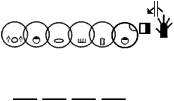
Stefan
...download PDF...
|
|
| 2 VIDEO |
|
|
| |
Teacher Stefan Woehrmann works with his Deaf students at the Osnabrück School for the Deaf, using SignWriting, a way to read and write sign languages combined with Woehrmann's SpeechWriting - a way to write the movements of spoken language on the lips, using a computer program developed in Germany called the DELEGS Editor, a useful tool in the classroom for teaching language, as you can see in this video! |
|
| 3 Animation |
|
|
4 PAPERS |
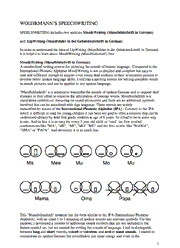 |
PAPER 1:
How I Teach
Mundbildschrift
by
Stefan Wöhrmann
Download in PDF |
| |
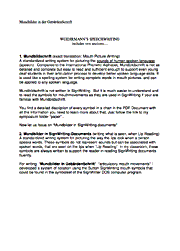 |
PAPER 2:
Mundbilder in
SignWriting
and Spelling rules
by
Stefan Wöhrmann
Download in PDF |
| |
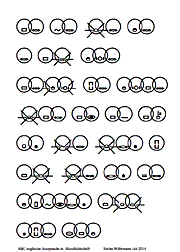 |
PAPER 3:
ABC (the Alphabet)
in
Mundbildschrift
For English
by
Stefan Wöhrmann
Download in PDF |
| |
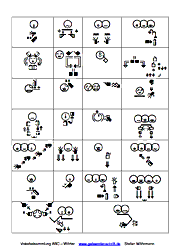 |
PAPER 4:
ABC Tabelle Neu
SignWriting Deutsch
by
Stefan Wöhrmann
Download in PDF |
| |
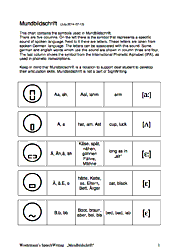 |
PAPER 5:
An Overview of
Symbols in
Mundbildschrift
by
Stefan Wöhrmann
Download in PDF |
| |
|
|
| 5 AUTHOR |
|
|
| |
|
|
|
|
Search
Google

|
|
|
|
|
Webmaster:
Valerie Sutton
Sutton@SignWriting.org
|
|
|
|
|
|
|
|
|
|
|
|
|
|
|
|
|
|
|
|
|
|
|
|
|
|
|
|
|
|
|
|
|
|
|
|
|
|
|
|
|
|
|
|
|
|
|
|
|
|
|
|
|
|
|
|
|
|
|
|
|
|
|
|
|
|
|
|
|
|
|
|
|
|
|
|
|
|
|
|
|
|
|
|
|
|
|
|
|
|
|
|
|
|
|
|
|
|
| |
| |
| |
| |
| |
| |
| |
| |
| |
| |
| |
| |
| |
| |
| |
| |
| |
| |
| |
| |
| |
| |
| |
| |
| |
| |
| |
| |
| |
| |
| |
| |
| |
| |
| |
| |
| |
| |
| |
| |
| |
| |
| |
| |
| |
| |
| |
| |
| |
| |
| |
| |
| |
| |
| |
| |
| |
| |
| |
| |
| |
| |
| |
| |
| |
| |
| |
| |
| |
| |
| |
| |
| |
| |
| |
| |
| |
| |
| |
| |
| |
| |
| |
| |
| |
| |
| |
| |
| |
| |
| |
| |
| |
| |
| |
| |
| |
| |
| |
| |
| |
| |
| |
| |
| |
| |
| |
| |
| |
| |
| |
| |
| |
| |
| |
| |
| |
| |
| |
| |
| |
| |
| |
|

SignWriting
Symposium
Home |

SignWriting
Symposium
on YouTube |

Search by
Authors |

Search by
Categories
|

Search by
List of
Presentations
|
View 68
Presentation
Web Pages
including
papers, slides,
bios & videos.
See below: |

2014
Presentations
|
2014
Presentation 1
SWORD Project
Research
Italy & France
Bianchini & Borgia |
2014
Presentation 2
Wöhrmann's
SpeechWriting
Education, Germany
Stefan Wöhrmann |
2014
Presentation 3
SW Handwriting
Write SW by Hand
Education, USA
Adam Frost |
2014
Presentation 4
SWift Digital
Editor, Software,
Italy & France
Borgia, Bianchini
& Marsico |
2014
Presentation 5
Deaf Child Literacy
Research, Brazil
Marianne Stumpf |
2014
Presentation 6
Deaf Literacy
with SignWriting
Education, Paraguay
Mirta Barreto |
2014
Presentation 7
New Testament
in Written ASL
Literature, USA
Nancy Romero |
2014
Presentation 8
Writing 48 Articles
in ASL Wikipedia
Literature, USA
Nancy Romero |
2014
Presentation 9
A Decade of
Teaching ASL
using SignWriting
Education, USA
Natasha Westland |
2014
Presentation 10
Ordering Signs
in Dictionaries
Education, USA
Charles Butler Neto |
2014
Presentation 11
SignPuddle
Standard
Software, USA
Steve Slevinski |
2014
Presentation 12
DELEGS-Editor
in Classroom
Education,
Germany
Stefan Wöhrmann |
2014
Presentation 13
SignWriter Studio
Software, Honduras
Jonathan Duncan |
2014
Presentation 14
Alternative
ISWA 2010 Fonts
Software, Honduras
Jonathan Duncan |
2014
Presentation 15
SignWriting in Deaf
Education, Tunisia
Balti, Bahri & Laajili |
2014
Presentation 16
Deaf Communication
Education, Brazil
Faulstich, Júnior
& Patrícia Santos |
2014
Presentation 17
SignWriting Teachers
Education, Brazil
Barreto, Souza,
Nascimento & Coelho |
2014
Presentation 18
Deaf Perspectives
Education, Brazil
Barreto, Souza,
Nascimento & Coelho |
2014
Presentation 19
TrueType in Graphite
Software, USA
Steve Slevinski
|
2014
Presentation 20
Sign Animating
Education, Canada
André Lemyre |
2014
Presentation 21
SignWriting App
Software, USA
Jake Chasan |
2014
Presentation 22
Children's Books
Literature, Portugal
Rafa Cota Silva |
2014
Presentation 23
TuniSigner Avatar
Software, Tunisia
Bouzid & Jemni |
2014
Presentation 24
Deaf Ed in Brazil
Education, Brazil
Stumpf & Barreto |
2014
Presentation 25
Reading SignWriting
Education, Brazil
Débora Wanderley |
2014
Presentation 26
SW Online Course
Education, Brazil
Barreto, Pereira
& Barbosa |
2014
Presentation 27
Film Online Course
Education, Brazil
Barreto & Goulart |
2014
Presentation 28
Language Analysis
Research USA
Erika Hoffmann |
2014
Presentation 29
SW in Deaf Schools
Education, USA
Denny Voreck |
2014
Presentation 30
SignWriting App
Education, USA
Elena Eroshkin |
2014
Presentation 31
Digital SW Texts
Software, USA
Steve Slevinski |
2014
Presentation 32
SW & Phonology
Research, Brazil
Costa & Barreto |
2014
Presentation 33
SW-OGR
Software, Italy
Borgia & Marsico |
2014
Presentation 34
SignWriting in
Catholic Liturgy
Education, Slovenia
Edi Strouhal |
2014
Presentation 35
Escrita de Sinais
Education, Brazil
Barreto & Barreto |
2014
Presentation 36
SW Terminolgy
Research, Brazil
Lima & Barreto |
2014
Presentation 37
SW Translation
Research, Brazil
Barreto & Oliveira |
2014
Presentation 38
SignWriting in
Music Scores
Literature, USA
Ron Shalom |
2014
Presentation 39
Writing Maltese
Sign Language
Research, Malta
Maria Galea |
2014
Presentation 40
40 Years Writing
Sign Languages:
1974-2014
Research, USA
Valerie Sutton |

2015
Presentations |
2015
Presentation 41
Javascript Keyboard
Software, Canada
Yair Rand |
2015
Presentation 42
Teacher's Attitudes
SW in Education
Saudi Arabia
AbuShaira, Mahfooz |
2015
Presentation 43
SignWriting Stack
Software, USA
Steve Slevinski |
2015
Presentation 44
DELEGS-Editor
Education, Germany
Stefan Wöhrmann |
2015
Presentation 45
SignWriting
Electronic
Flashcards
Education, Canada
André Lemyre |
2015
Presentation 46
Reading SignWriting
Research, Brazil
Marcos Klüber Kogut |
2015
Presentation 47
SignWriting in Classroom
Education, Portugal
Rafa Cota Silva |
2015
Presentation 48
SignWriting
Journal System
Software, Brazil
Brito, Shintaku,
Ramos & Nascimento |
2015
Presentation 49
SignMaker 2015
Software, USA
Steve Slevinski |
2015
Presentation 50
Nicaraguan
Sign Language
Grammar
Education,Nicaragua
James Shepard-Kegl |
2015
Presentation 51
SignWriting Font
Research, Germany
Lentföhr, Nitschke
& Rutrecht |
2015
Presentation 52
MemoSign Game
Software, Tunisia
Bouzid, Khenissi |

2016
Presentations |
2016
Presentation 53
Home For
Deaf Children
Education, Peru
Kristina Tworek |
2016
Presentation 54
SignTyp Database
Research, USA
Rachel Channon |
2016
Presentation 55
FSW Formal
SignWriting
Software, USA
Steve Slevinski |
2016
Presentation 56
SignWriting in
Tunisian Deaf
Education, Tunisia
Laajili & Balti |
2016
Presentation 57
Parallel Corpora
Software, Brazil
Alex M. Becker |
2016
Presentation 58
Deaf Writing Skills
Education, Portugal
Jorge Manuel Pinto |
2016
Presentation 59
Bilingual Deaf
Education, Brazil
Almeida & Júnior |
2016
Presentation 60
Bilingual Deaf
Education, Brazil
Daniele Bózoli |
2016
Presentation 61
SignWriting
in Unicode
Software, USA
Steve Slevinski |
2016
Presentation 62
SignPuddle 3.0
Software, USA
Steve Slevinski |
2016
Presentation 63
Peru Sign Dict
Research, Peru
Miguel Mondoñedo |
2016
Presentation 64
Sign Wikipedias
Literature, USA
Valerie Sutton
ASL Presentation by
Adam Frost, Jason
Nesmith, Holly Sharer
& the CODA Brothers
Plus special video on
Tunisian Sign Wikipedia
by Mohamed Ali Balti |

2017
Presentations |
2017
Presentation 65
SignÉcriture: A
Decade of Writing
French-Swiss
Sign Language
Education,
French-Switzerland
by Anne-Claude
Prélaz Girod |
2017
Presentation 66
The Sutton
SignWriting
Standard of 2017 Software, USA
by Steve Slevinski |
2017
Presentation 67
The Writing of Grammatical
Non-Manual Expressions
in Sentences
in LIBRAS
Using SignWriting
Research, Brazil
by Joao Paulo
Ampessan
|
2017
Presentation 68
Sign Language Writing:
SignWriting as a
Tool in
Deaf Literacy
Education, Brazil
Fernando Carneiro Priscila Bartoletti |
2017
Presentation 69
SignWriting Presentations
at the ICONIL in
Bacabal,Brazil
August 2017
by Adam Frost & Marianne Stumpf |
2017
Presentation 70
2 Brazilian
TV Programs
on SignWriting
on TV INES,
Brazil, 2017 |
| |
2014
Live Streaming
40 Presentations
 |
2015
Live Streaming
12 Presentations
 |
2016
Live Streaming
12 Presentations
 |
|

















